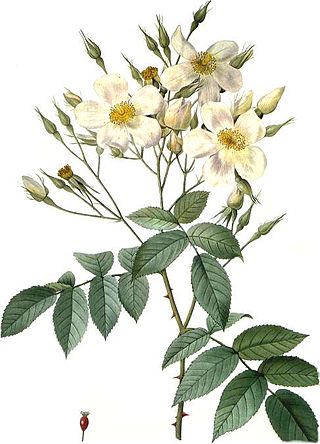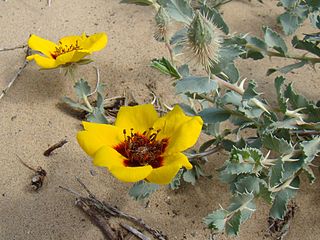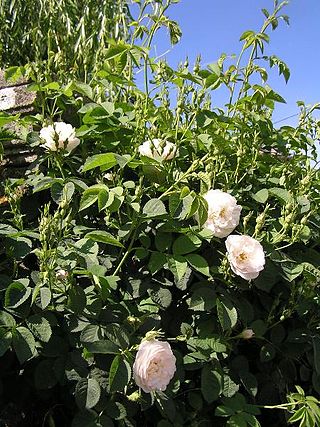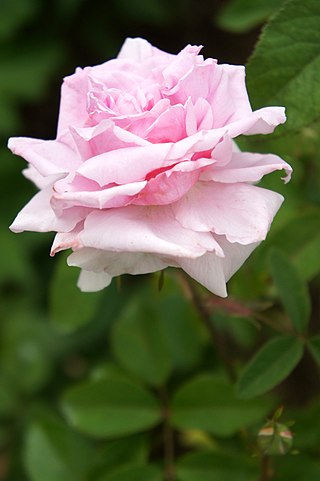
Lavandula is a genus of 47 known species of perennial flowering plants in the mints family, Lamiaceae. It is native to the Old World, primarily found across the drier, warmer regions of mainland Eurasia, with an affinity for maritime breezes.

A rose is either a woody perennial flowering plant of the genus Rosa, in the family Rosaceae, or the flower it bears. There are over three hundred species and tens of thousands of cultivars. They form a group of plants that can be erect shrubs, climbing, or trailing, with stems that are often armed with sharp prickles. Their flowers vary in size and shape and are usually large and showy, in colours ranging from white through yellows and reds. Most species are native to Asia, with smaller numbers native to Europe, North America, and northwestern Africa. Species, cultivars and hybrids are all widely grown for their beauty and often are fragrant. Roses have acquired cultural significance in many societies. Rose plants range in size from compact, miniature roses, to climbers that can reach seven meters in height. Different species hybridize easily, and this has been used in the development of the wide range of garden roses.

Rose water is a flavoured water made by steeping rose petals in water. It is the hydrosol portion of the distillate of rose petals, a by-product of the production of rose oil for use in perfume. Rose water is also used to flavour food, as a component in some cosmetic and medical preparations, and for religious purposes throughout Eurasia.

Used in perfumery and aromatherapy, absolutes are similar to essential oils. They are concentrated, highly aromatic, oily mixtures extracted from plants. Whereas essential oils are produced by distillation, boiling, or pressing, absolutes are produced through solvent extraction, or more traditionally, through enfleurage.

Rosa 'Ispahan', also known as 'Rose d'Ispahan' and 'Pompon des Princes', is a clear pink, half-open kind of Damask rose, a type of garden rose introduced from the Middle East to Europe during the crusading 13th century.

Rosa gallica, the Gallic rose, French rose, or rose of Provins, is a species of flowering plant in the rose family, native to southern and central Europe eastwards to Turkey and the Caucasus. Rosa gallica was one of the first species of rose to be cultivated in central Europe. It is a parent of several important cultivars.

Rose oil is the essential oil extracted from the petals of various types of rose. Rose ottos are extracted through steam distillation, while rose absolutes are obtained through solvent extraction, the absolute being used more commonly in perfumery. The production technique originated in Greater Iran. Even with their high price and the advent of organic synthesis, rose oils are still perhaps the most widely used essential oil in perfumery.

Rosa 'Mister Lincoln', also known as 'Mr. Lincoln', is a dark red hybrid tea rose cultivar. Bred by Herbert Swim and Weeks Rose Growers in 1964, the rose was named an All-America Rose Selections winner in 1965.

Rosa × centifolia, the Provence rose, cabbage rose or Rose de Mai, is a hybrid rose developed by Dutch breeders in the period between the 17th century and the 19th century, possibly earlier.

Rosa 'La France' is a pink rose cultivar found in France in 1867 by the rosarian Jean-Baptiste André Guillot (1827–1893). It is generally accepted to be the first hybrid tea rose. Its introduction is therefore also considered the birth of the modern rose. As the cultivar was not systematically bred, its hybrid parentage can only be speculated, but 'Madame Falcot' is considered as a possible parent.

Rosa moschata, the musk rose, is a species of rose which has been long in cultivation. Its wild origins are uncertain but are suspected to lie in the western Himalayas.

Rosa 'Old Blush', also known as 'Parsons' Pink China', 'Old Blush China', 'Old China Monthly', is a China rose and has been cultivated in China for over a thousand years. It derives from Rosa chinensis, and is generally accepted as the first East Asian rose cultivar to reach Europe. It is recorded in Sweden in 1752 and in England before 1759, but was probably cultivated in China for several centuries. It is believed to be the rose which inspired the song The Last Rose of Summer by the Irish composer and poet Thomas Moore. It is also known as Parsons' Pink China, named after Mr Parson who introduced it commercially to the UK in 1793.

Rosa persica is an anomalous species of rose that at one time was placed in a separate genus Hulthemia. It is native to deserts and steppes from Iran and Afghanistan in the south, through Central Asia, to western Siberia in the north. Its distinctive characteristics include a simple leaf without stipules, and a distinctive flower with a darker coloured central zone. In its natural habitat it is a deep-rooted weed that suckers – growing in Iranian fields for example, where it is collected for fuel once the grain crop has been harvested – but it is difficult to grow in gardens and rarely cultivated.

Garden roses are predominantly hybrid roses that are grown as ornamental plants in private or public gardens. They are one of the most popular and widely cultivated groups of flowering plants, especially in temperate climates. An enormous number of garden cultivars have been produced, especially over the last two centuries, though roses have been known in the garden for millennia beforehand. While most garden roses are grown for their flowers, often in dedicated rose gardens, some are also valued for other reasons, such as having ornamental fruit, providing ground cover, or for hedging.

Remontancy is the ability of a plant to flower more than once during the course of a growing season or year. It is a term applied most specifically to roses, and roses possessing this ability are called "repeat flowering" or remontant. The term originated in the nineteenth century from the French verb remonter or 'coming up again'. Roses which lack this ability are termed "summer flowering", "once flowering" or non-remontant. Few wild rose species possess remontancy; notable exceptions being Rosa chinensis, Rosa rugosa and Rosa fedtschenkoana.

Rosa × alba, the white rose of York, is a hybrid rose of unknown parentage that has been cultivated in Europe since ancient times. It may have originally been grown mainly for the sweet scent of the flowers, but is now also used as a winter-hardy garden shrub. Cultivated forms have white or pink flowers, and most have many petals. Hybrid cultivars have also been produced with red or yellow flowers.

Rosa 'Boscobel' is a pink shrub rose cultivar, bred by British rose breeder David C. H. Austin, and introduced into the UK by David Austin Roses Limited (UK) in 2012. The cultivar was named after Boscobel House (1632) in Shropshire, England.

Rosa 'Munstead Wood' is a dark red shrub rose cultivar, bred by British rose breeder David C. H. Austin, and introduced into the UK by David Austin Roses Limited (UK) in 2007. The cultivar was named after horticulturalist and garden designer Gertrude Jekyll's home, Munstead Wood, in Surrey, England. The rose was awarded the Award of Garden Merit (AGM) by the British Royal Horticultural Society (RHS) in 2007 and an American Garden Rose Selections (AGRS) Fragrance Award, in 2017.

Rosa 'The Mayflower' is a medium-pink shrub rose cultivar, bred by British rose breeder David C. H. Austin in 1992 and introduced into the UK by David Austin Roses Limited (UK) in 2001. It was named to celebrate the initial publication of the company's American catalogue of roses.

Rosa 'The Countryman' is a pink shrub rose cultivar, created by British rose breeder David C. H. Austin. It was named for The Countryman magazine. The rose was introduced into the UK by David Austin Roses Limited (UK) in 1979.





















